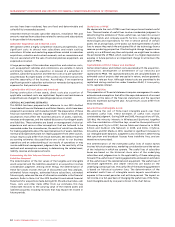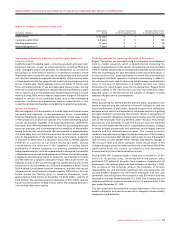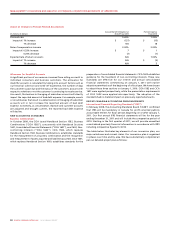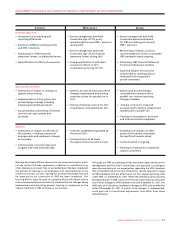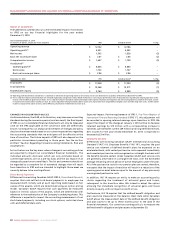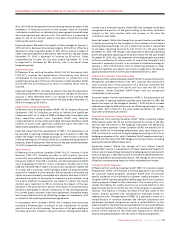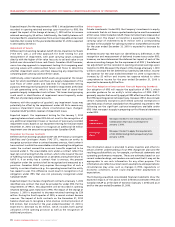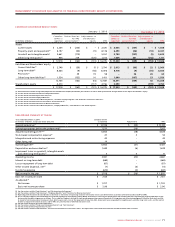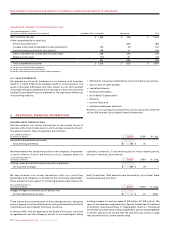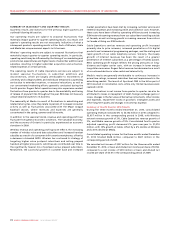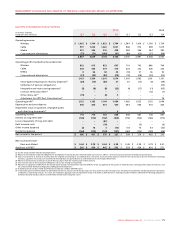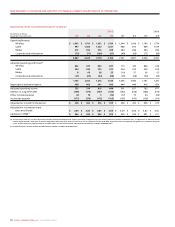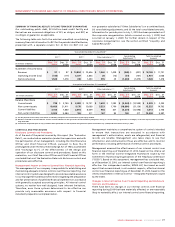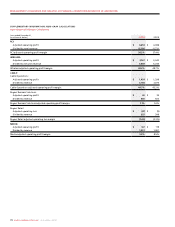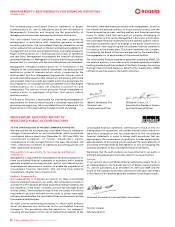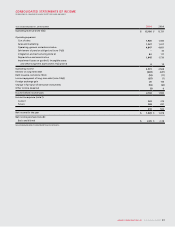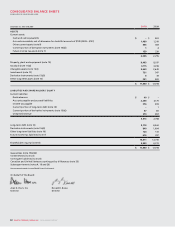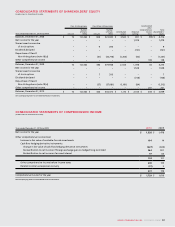Rogers 2010 Annual Report Download - page 70
Download and view the complete annual report
Please find page 70 of the 2010 Rogers annual report below. You can navigate through the pages in the report by either clicking on the pages listed below, or by using the keyword search tool below to find specific information within the annual report.
MANAGEMENT’S DISCUSSION AND ANALYSIS OF FINANCIAL CONDITION AND RESULTS OF OPERATIONS
74 ROGERS COMMUNICATIONS INC. 2010 ANNUAL REPORT
market penetration have been met by increasing customer service and
retention expenses and increasing credit and collection costs. However,
these costs have been offset by operating efficiencies and increasing
GSM network roaming revenues from our subscribers travelling outside
of Canada, as well as strong growth in roaming revenues from visitors
to Canada utilizing our GSM network.
Cable Operations services revenue and operating profit increased
primarily due to price increases, increased penetration of its digital
products and incremental programming packages, and the scaling and
rapid growth of our cable telephony service. Similarly, the steady
growth of Internet revenues has been the result of a greater
penetration of Internet subscribers as a percentage of homes passed.
RBS’s operating profit margin reflects the pricing pressures on long-
distance and higher carrier costs, with an increase in lower margin
long-distance revenue. Rogers Retail revenue has decreased as a result
of a continued decline in video rental and sales activity.
Media’s results are generally attributable to continuous increases in
prime time ratings, increased subscriber fees and improvements in the
advertising market. The launch of Sportsnet ONE in the latter part of
2010 resulted in incremental costs, while only limited revenues were
realized in 2010.
Other fluctuations in net income from quarter-to-quarter can also be
attributed to losses on repayment of debt, foreign exchange gains or
losses, changes in the fair value of derivative instruments, other income
and expenses, impairment losses on goodwill, intangible assets and
other long-term assets and changes in income tax expense.
Summary of Fourth Quarter 2010 Results
During the three months ended December 31, 2010, consolidated
operatingrevenueincreased3%to$3,152millionin2010comparedto
$3,057 million in the corresponding period in 2009, with Wireless
networkrevenuegrowthof3%,CableOperationsrevenuegrowthof
2%,andMediarevenuegrowthof9%.Consolidatedfourthquarter
adjusted operating profit decreased 2% year-over-year to $1,074
million,with14%growthatCable,offsetbya6%declineatWireless
anda33%declineatMedia.
Consolidated operating income for the three months ended December
31, 2010 totalled $648 million, compared to $607 million in the
corresponding period of 2009.
We recorded net income of $327 million for the three months ended
December 31, 2010, or basic and diluted net income per share of $0.58,
compared to a net income of $310 million or basic and diluted net
income per share of $0.51 in the corresponding period of 2009.
SUMMARY OF SEASONALITY AND QUARTERLY RESULTS
Quarterly results and statistics for the previous eight quarters are
outlined following this section.
Our operating results are subject to seasonal fluctuations that
materially impact quarter-to-quarter operating results. As a result, one
quarter’s operating results are not necessarily indicative of what a
subsequent quarter’s operating results will be. Each of Wireless, Cable
and Media has unique seasonal aspects to its business.
Wireless’ operating results are subject to seasonal fluctuations that
materially impact quarter-to-quarter operating results. In particular,
operating results may be influenced by the timing of our marketing and
promotional expenditures and higher levels of subscriber additions and
subsidies, resulting in higher subscriber acquisition and activation-
related expenses in certain periods.
The operating results of Cable Operations services are subject to
modest seasonal fluctuations in subscriber additions and
disconnections, which are largely attributable to movements of
university and college students and individuals temporarily suspending
service due to extended vacations, or seasonal relocations, as well as
our concentrated marketing efforts generally conducted during the
fourth quarter. Rogers Retail operations may also experience modest
fluctuations from quarter-to-quarter due to the availability and timing
of release of popular titles throughout the year. RBS does not have any
unique seasonal aspects to its business.
The seasonality at Media is a result of fluctuations in advertising and
related retail cycles, since they relate to periods of increased consumer
activity as well as fluctuations associated with the Major League
Baseball season, where revenues and expenses are generally
concentrated in the spring, summer and fall months.
In addition to the seasonal trends, revenue and operating profit can
fluctuate from general economic conditions. The Canadian economy,
and the economy of Ontario in particular, experienced an economic
slowdown in 2009.
Wireless revenue and operating profit growth reflects the increasing
number of wireless voice and data subscribers and increased handset
subsidies as a result of a consumer shift towards smartphones, offset by
a decrease in blended ARPU. Wireless has continued its strategy of
targeting higher value postpaid subscribers and selling prepaid
handsets at higher price points, which has also contributed over time to
the significantly heavier mix of postpaid versus prepaid subscribers.
Meanwhile, the successful growth in customer base and increased


